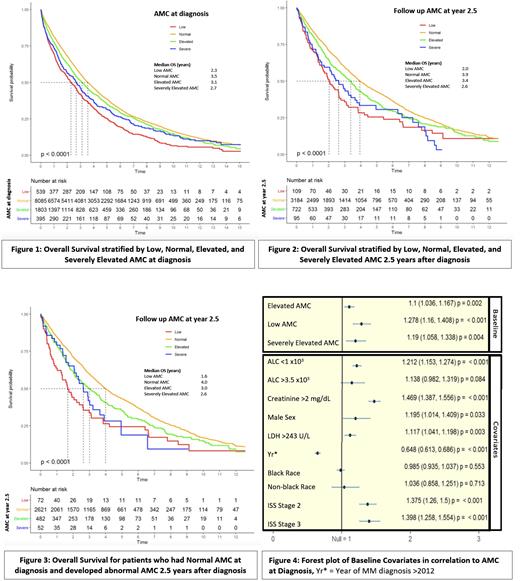Abstract
Introduction: Multiple myeloma (MM) is a heterogeneous disease with diverse clinical outcomes. Although survival in MM has improved, high risk patients still experience early relapses and shorter survival. Current methods for risk stratification in MM are useful at diagnosis but need to be refined as our knowledge of disease pathobiology evolves. Tumor-associated macrophages, derived from peripheral blood monocytes, support malignant plasma cell proliferation in the bone marrow (BM) microenvironment. Since peripheral blood absolute monocyte count (AMC) could reflect the BM microenvironment, we evaluated the prognostic significance of AMC in MM at diagnosis and during the disease course.
Methods: We used the nationwide Veterans Affairs electronic health records to include treatment-naïve MM patients diagnosed between 2000 and 2019 without concomitant aplastic anemia, myelodysplastic syndrome, myeloproliferative neoplasm, and acute or chronic leukemia. We obtained AMC (x10 3) closest to and within 90 days from diagnosis and every 3 months thereafter up to 2.5 years. Patients were stratified into 4 AMC groups: low (AMC < 0.2), normal (AMC 0.2 to < 0.8), elevated (AMC 0.8-1.25), and severely elevated (AMC > 1.25). Our selection criteria excluded any treatment-related change in AMC. Overall survival (OS) was evaluated using the Kaplan-Meier estimator and logrank tests. Cox proportional hazard models were used for multivariable analysis.
Results: We analyzed 10,822 patients, median age 70 years (interquartile range [IQR] 63-77) with a median follow up of 2.9 years (IQR 1.3-5.3). At diagnosis, 25.3% of patients (2737 of 10,822) presented with abnormal AMC; with 5% having low, 16.7% elevated, and 3.6% severely elevated AMC. Patients with monocytosis (elevated or severely elevated AMC) were younger and more likely to have higher median levels of beta-2-microglobulin and lactate dehydrogenase (LDH) and lower median levels of albumin (p < 0.001) than those without monocytosis. Abnormal AMC at diagnosis significantly impacted overall survival (p < 0.001) . Patients with low, severely elevated, elevated, and normal AMC at diagnosis had median OS of 2.3, 2.7, 3.1, and 3.5 years (p < 0.001), respectively (Figure 1). Persistent AMC abnormality also impacted outcomes. Abnormal AMC > 1 year after diagnosis was also associated with inferior OS (median OS at 2.5 years - 2.0, 2.6, 3.4, and 3.9 years in patients with low, severely elevated, elevated, and normal AMC respectively [p < 0.001]) (Figure 2). If patients with normal AMC at diagnosis developed an abnormal AMC > 1 year after diagnosis, median OS was reduced relative to if they maintained normal AMC (Figure 3). Notably, median OS improved across all AMC groups in patients with MM diagnosed after 2012 when modern therapies became standard of care. However, the adverse survival impact of low, elevated, or severely elevated AMC persisted in all time periods. After adjusting for known prognostic factors (age, ISS Stage, LDH), multivariable analysis showed similar results, with a significant association of OS with AMC at diagnosis (Figure 4) and AMC measured up to 2.5 years after diagnosis. Hazard Ratios (HR) at diagnosis were 1.28 (95% confidence interval [CI] 1.16-1.41; p < 0.001), 1.10 (95%CI 1.04-1.17; p = 0.002), and 1.19 (95%CI 1.06-1.34; p = 0.004), and HRs at 2.5 years after diagnosis were 1.53 (95%CI 1.22-1.93; p < 0.001), 1.11 (95%CI 1.00-1.23; p = 0.043, 1.58 (95%CI 1.22-2.04; p < 0.001) for low, elevated and severely elevated AMC, respectively.
Conclusion: Abnormal AMC is frequently observed in MM and is a powerful, easily attainable prognostic biomarker. Abnormal AMC at diagnosis or follow up of MM is significantly associated with inferior OS, independent of established prognostic factors. Survival was also inferior for patients who had normal AMC at diagnosis but then developed abnormal AMC, possibly suggesting changes in the BM microenvironment over time. Given the improved prognosis of patients with severely elevated AMC in patients diagnosed with MM after 2012, our data potentially highlights the mechanism of action of novel treatments interacting with the tumor microenvironment. Whether these findings reflect disease biology, a consequence of disease progression, or both warrants further in vitro, prospective studies. Overall, AMC is a readily available metric that could be included in the risk stratification of MM at diagnosis and beyond.
Munshi: Takeda: Consultancy; Bristol-Myers Squibb: Consultancy; Amgen: Consultancy; Janssen: Consultancy; Legend: Consultancy; Novartis: Consultancy; Adaptive Biotechnology: Consultancy; Pfizer: Consultancy; Karyopharm: Consultancy; Celgene: Consultancy; Oncopep: Consultancy, Current equity holder in publicly-traded company, Other: scientific founder, Patents & Royalties; Abbvie: Consultancy.


